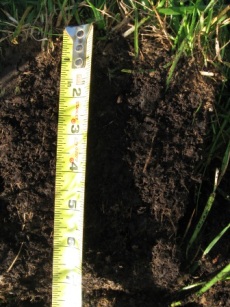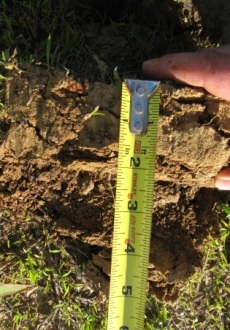Amended Soils Disconnection
Amended soils are considered in areas where other more preferred BMP options, such as bioretention, are not feasible.
Amended soils disconnection manages runoff close to the source, preventing impervious surfaces from discharging directly to the sewer system by directing the runoff to compost amended soils. The amended soils provide a “sponge” for absorbing water that is then infiltrated, evaporated, and transpirated in turf areas. This practice is effective not only in reducing runoff but can also be designed as a stand alone water quality BMP if capable of capturing and treating the required water quality volume, removing required 80% of total suspended solids and having an acceptable longevity rate in the field.
Performance Criteria, Specifications and Maintenance requirements along with examples of a rooftop disconnection and a linear pavement disconnection are accessed through the links below. Although only rooftop and trail disconnection examples are presented, this practice may be applied as the Performance Criteria allows for other linear impervious surfaces such as roadways and sidewalks.
Maintenance
A properly designed disconnection area will require typical lawn or landscaping maintenance. Protecting the amended soil area from soil compaction and on-site development (example: patios, decks, sheds) will help to avoid or minimize the need for repairs over its life. Additional BMP ownership and maintenance guidance, inspection checklists and annual reporting requirements is found at Maintenance Responsibilities.
Amended soil areas are to be indicated on the site construction plans and are typically located in defined recorded BMP reserve areas. MSD permits will be necessary for amended soil areas. The installation and “tilling in” of the soil amendments shall be completed before final seeding or sodding. The project’s BMP Maintenance Agreement requires that the amended soil areas be preserved. These areas are subject to routine ongoing MSD compliance inspections, to verify the amended soil area still exists and is functioning properly.
When amended soils are used, MSD encourages that they be located outside the building setback lines (i.e., further away from the house and related improvements). Amended soil areas should not be located in areas where other improvements such as patios, swimming pools, decks, retaining walls or other similar items are proposed or may be constructed by future end users. They also should not be located in areas used for vehicle or other item storage or in areas subjected to ground compaction. The amended soil area must be able to receive and treat its designed runoff volume, and these site considerations will help to avoid or minimize the need for repair work over the life of the amended soil. Designers should also consider possible foundation seepage issues when locating amended soil areas near buildings/basements.
In some instances, when house building footprints are unknown and it is then difficult to determine the exact reserve area for the amended soils, it shall not be required that the maintenance agreement and/or record plat define or depict a reserve area. In this case, the amended soil requirements shall be listed in the subdivision indentures and also on the approved site construction plans, including the square footage of amended soil required for the corresponding square footage of area that will be draining to it (1:1 ratio, example – drainage from 400 square feet of roof area is dispersed out and drains evenly onto 400 square feet of amended soil area). Language in the subdivision indentures shall list each lot number required to have amended soil. The indentures shall also mention that amended soil areas shall not be used for vehicle or other item storage, shall not be subjected to ground compaction, and that improvements such as patios, swimming pools, decks, retaining walls or other similar items shall not be constructed within the amended soil areas. The indenture language shall reference the MSD approved site construction plans, MSD approved maintenance and operations manual, and the project maintenance agreement for more detailed requirements and information. Modifications to amended soils areas shall not be made without obtaining prior approval from Directors, the Municipality, and MSD.

Compost-Amended Soil

Compacted Construction Soil

